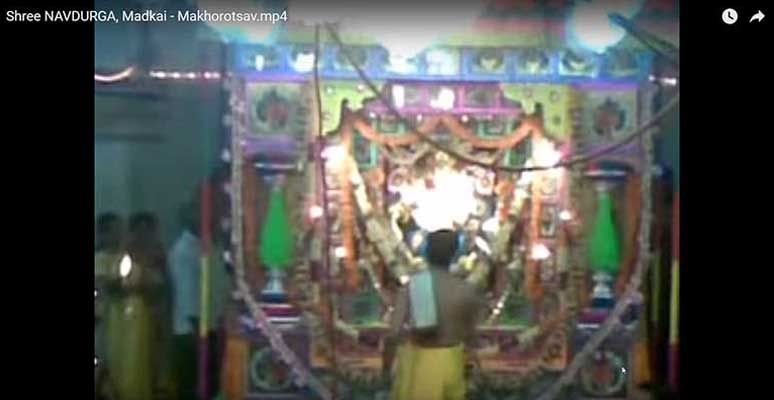Dussehra depicts the battle of Goddess Durga with the powerful demon, Mahishasura. The Bengalis worship Durga along with four other deities – Ganesha, Kartikeya, Lakshmi, and Saraswati. The festival starts on the sixth day (Sashti) when the idol of Durga is inaugurated and decorated in the pandals. This ceremony ends on Vijaya Dashami (Dussehra). That’s when the clay statute of the Goddess is immersed in the rivers or lakes nearby. Devotees bid adieu to the deity. Gujaratis associate the festival with that energetic dance called Dandiya Raas where couples dance with small sticks clacking against each other.
How is Navratri and Dussehra celebrated differently in Goa?
Well, for one, Goan cuisine is not the same as that in West Bengal and Gujarat. Each state has its own tastes and its own cuisine. So, while rosogullas are popular during Dussehra in Kolkata, and with dhoklas in Gujarat; in Goa, you’ll get served puran polis and shrikhand. Also, in Goa, this celebration is called ‘Dasro’ – in the Konkani language.
Yes, even in Goa, Navratri and Dussehra, basically still depict the triumph of good over evil and unholy. Yes, here too it’s celebrated by burning the idol of Ravana to display Lord Ram’s victory over Ravana. And with the immersion of the clay statue of the Goddess Durga. You also see flower vendors making long garlands of orange marigold flowers. However, the celebrations in Goa, have their own unique tradition and flavor.

Not just Durga but Shantadurga, in Goa
In Goa, Dussehra festival has more than just the dandiya dance. Goans believe that after the victorious battle in which goddess Durga killed the demon Mahishasura, the Goddess Durga became very peaceful and took up residence in Gomaanchal (Goa). She then got the name Shantadurga. The famous Shantadurga temple in Ponda is where she resides.
Dussehra in Go is the marriage of Lord Shiva with the goddess Shakti.
Here, in Goa, the festival is also celebrated as the marriage of Lord Shiva with the Goddess Shakti. In fact, here, Parvati, who is Shiva’s consort, is worshiped in the various forms of goddess Durga such as Mauli, Sateri, Shantadurga, Bhumika. So, wherever these temples are located, the festivities also take those forms and especially include decorative umbrellas locally known as the tarangas.
Navratri in Pernem – Taranga Mel dance and Lord Bhutnath being pacified
In Pernem, the Dussehra/Navratra celebrations are associated with the festival of Pednechi Punav. Here, the celebration is also known as as ‘Kojagiri Poornima.’ In the past, the Royal family of Pernem – the Deshprabhus celebrated this feast with great pomp and splendor. These days, too they partake in the main puja, but most of the nine-day celebrations are organized by the Shree Bhagwati Devasthan of Pernem
During the nine nights, the Kotkar clan prepare the flower toran (a garland of orange marigolds and mango leaves) while the Guravs (local priests), Kumbhars (potters) and sutars (carpenters) prepare the Taranga (a decorative umbrella that is representative of a God or Goddess) and the Mahar community beats the drums (Dhol). In some temples in Goa, they carry that Taranga and do the ‘Tarangme’ dance – a very energetic dance, of very elaborate dance steps while holding that decorative umbrella. The Tarangamel is also danced during Holi celebrations when a drum called the “Romut” is played. On the ninth night, Lord Bhutnath must be pacified.
In Pernem, at midnight on the ninth night, religious persons called ‘gaddas’ who are believed to be incarnations of Lord Bhutnath, run into the forest in pure ecstasy. Lord Bhutnath’s devotees then follow these ‘gaddas’ into the forest. Their job is to try to pacify the angry Lord Bhutnath, who, it is believed, does not have his own temple, and so demands a temple be built that night itself. The Lord’s devotees, realizing that the temple cannot be built in just one night, pacify him by saying, “Bandtoi-ba-saiba“ (Lord, we’re building it Lord). After the Lord is pacified, the Navratri celebrations come to an end.

Pic credit: Chillgoa.com
Navratri in Paingini (Canacona) celebrated differently
Imagine dancing with almost gay abandon, in almost sheer chaos. The folks in Paingini have such a dance called ‘Gondhol’. They perform this dance with pure joy during Dussehra, here’s how the celebrations and dance take place. For the people of Paingini village in Canacona, Navraatri means worship of the Tarangas, and Satri (umbrella shaped religious icons) which represent the local.
During Dussehra/Navratra, the ‘Tarang’, the ‘Satri’ and a big bunch of vibrant peacock feathers called the ‘Niraakaaracho Pillkucho’ are carried in processions. The Satri is a representation of Navdurga. The ‘Pillkucho’ is a representation of the Nirakar (the formless). The people of Paingini welcome the Tarang, The Satri and the Pillkucho procession with oil lamps and throw fragrant flowers in its path throughout the night till the procession reaches the Shri Navdurga temple. At night, they dance the traditional ‘Gondhol” (Gondhol’ literally means chaos). This is a very elaborate and energetic dance performed to the heart throbbing beats of the dhol and the taasha.
Navratri at the Navadurga temple at Borim (Ponda)
At the Navadurga Temple in Ponda, during Navratri, the puja includes the swinging of a solid gold idol on a special hundred-year-old swing known as a makhar. There is an interesting story behind the gold idol.
This story dates back to the time when the Ranes raided Goa’s rich families. The ‘Saukars’, who were Borim’s biggest landlords decided to protect their family gold and hide it so that it didn’t fall into the Rane’s hands. Later, however, the family fell on troubled times and prayed to their temple Goddess to help them. They promised the Goddess that in return for her help, they would make a solid gold idol of the Goddess. Their prayers were answered. So the idol that’s in the Navadurga temple is an idol made from their family’s gold. It is known as Kancholi Devi.
Click here for a video of the puja on the makhar swing.



